- Synthetic Laboratory Experiment
- Gas Pressure Pulse Decay Experiment
- Five Spot Injection-Production in Geothermal Reservoir
- Yucca Mountain
- Ventilation Experiment
- Well Test Design
- Optimization of Air-Sparging System
Synthetic Laboratory Experiment
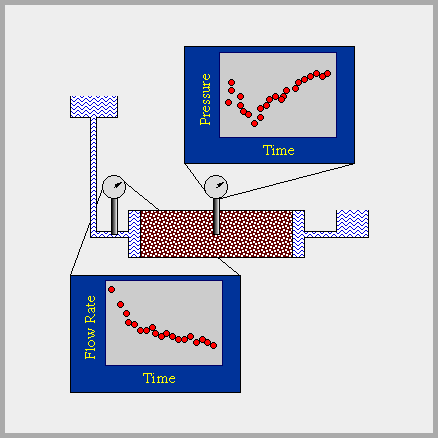 The inversion of pressure and flow rate data from a synthetic laboratory experiment exhibiting two-phase flow effects demonstrates a variety of the inverse modeling capabilities implemented in iTOUGH2. The example is discussed in the iTOUGH2 Sample Problems.
The inversion of pressure and flow rate data from a synthetic laboratory experiment exhibiting two-phase flow effects demonstrates a variety of the inverse modeling capabilities implemented in iTOUGH2. The example is discussed in the iTOUGH2 Sample Problems. ![]()
Pressure Pulse Decay Experiment
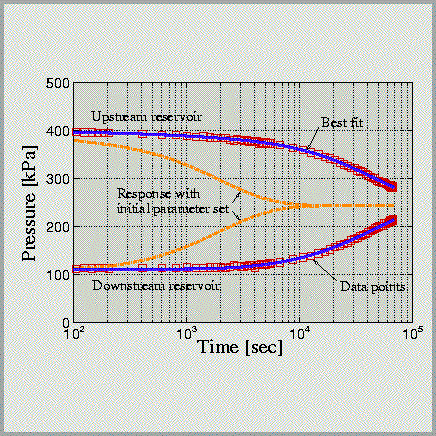 Pressure data from Gas-Pressure-Pulse-Decay (GPPD) experiments were inverted to estimate absolute permeability, the Klinkenberg slip factor, and porosity of a Graywacke core sample. The example shows the importance of the error analysis for the identification of strong parameter correlations and systematic errors. The example also demonstrates the potential advantage of using robust estimators for minimizing the bias from systematic errors. The analysis is described in Finsterle and Persoff [1997] and Finsterle and Najita [1998].
Pressure data from Gas-Pressure-Pulse-Decay (GPPD) experiments were inverted to estimate absolute permeability, the Klinkenberg slip factor, and porosity of a Graywacke core sample. The example shows the importance of the error analysis for the identification of strong parameter correlations and systematic errors. The example also demonstrates the potential advantage of using robust estimators for minimizing the bias from systematic errors. The analysis is described in Finsterle and Persoff [1997] and Finsterle and Najita [1998]. ![]()
Injection-Production in Geothermal Reservoir
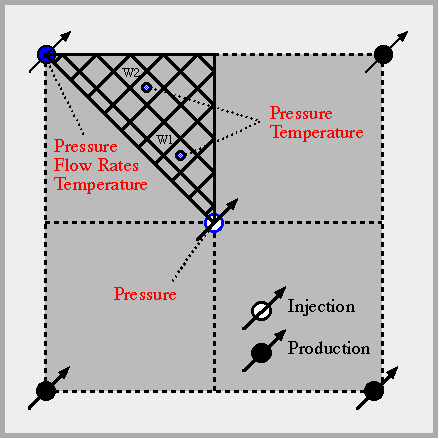 Data commonly obtained during geothermal production (pressures, temperatures, liquid and steam flow rates, enthalpies, etc.) can be used to calibrate a model of the geothermal reservoir. The calibrated model can then be used to study and optimize future field management scenarios such as reinjection of condensate. iTOUGH2 has been used to estimate hydrogeologic and thermal properties as well as fracture spacing for a synthetic geothermal field. The inverse modeling results are discussed in detail in Finsterle and Pruess [1995]. The use of optimization techniques for geothermal management problems is outlined in Finsterle and Pruess [1997]. An application to actual field data is described in Finsterle et al. [1997].
Data commonly obtained during geothermal production (pressures, temperatures, liquid and steam flow rates, enthalpies, etc.) can be used to calibrate a model of the geothermal reservoir. The calibrated model can then be used to study and optimize future field management scenarios such as reinjection of condensate. iTOUGH2 has been used to estimate hydrogeologic and thermal properties as well as fracture spacing for a synthetic geothermal field. The inverse modeling results are discussed in detail in Finsterle and Pruess [1995]. The use of optimization techniques for geothermal management problems is outlined in Finsterle and Pruess [1997]. An application to actual field data is described in Finsterle et al. [1997]. ![]()
Yucca Mountain
 iTOUGH2 has been used for the calibration of the three-dimensional site-scale unsaturated zone model of Yucca Mountain. The data matched include saturations, water potentials, and pneumatic pressures. Simultaneous inversions of data from several boreholes were performed. The resulting parameter set was then validated by comparing simulation results of a selected two-dimenional cross-section of Yucca Mountain with independent data such as inferred gas flow patterns, fast flow path, and temperature data.
iTOUGH2 has been used for the calibration of the three-dimensional site-scale unsaturated zone model of Yucca Mountain. The data matched include saturations, water potentials, and pneumatic pressures. Simultaneous inversions of data from several boreholes were performed. The resulting parameter set was then validated by comparing simulation results of a selected two-dimenional cross-section of Yucca Mountain with independent data such as inferred gas flow patterns, fast flow path, and temperature data.
See the following publications:
- Ghezzehei, et al., 2004, doi:10.2136/vzj2004.0806
- Unger, et al., 2004, doi: 10.1016/j.jconhyd.2003.07.001
- Finsterle, et al., 2003, doi: 10.1016/S0169-7722(02)00174-2
- Finsterle, 2000, doi: 10.1029/2000WR900122
- Ahlers, et al., 1999, doi: 10.1016/S0169-7722(99)00011-X

Ventilation Experiment
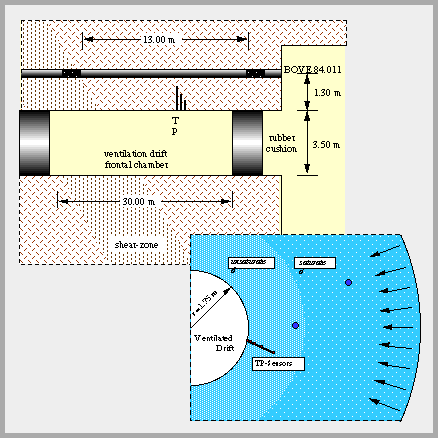 In situ measurements of water potentials at various distances from a drift wall were performed by ETHZ and Nagra, Switzerland, to study the extent of the two-phase zone that develops in the vicinity of a ventilated drift. iTOUGH2 was used to calibrate the data in order to determine absolute permeability and two-phase flow parameters of the granitic rock. The results are discussed in Finsterle and Pruess [1995].
In situ measurements of water potentials at various distances from a drift wall were performed by ETHZ and Nagra, Switzerland, to study the extent of the two-phase zone that develops in the vicinity of a ventilated drift. iTOUGH2 was used to calibrate the data in order to determine absolute permeability and two-phase flow parameters of the granitic rock. The results are discussed in Finsterle and Pruess [1995]. ![]()
Well Test Design
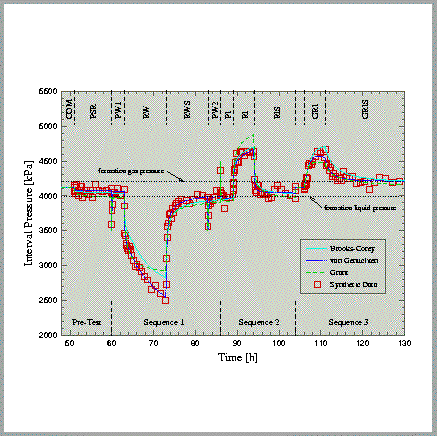 The error analysis provided by iTOUGH2 can be used to optimize the design of a laboratory experiment or field test. Performing synthetic data inversions allows one to identify the test design that potentially minimizes the uncertainty of the parameters to be determined. The approach is described in Finsterle and Faybishenko [1999] for a laboratory experiment, and in Finsterle and Pruess [1996] for a well test in a tight formation containing gas.
The error analysis provided by iTOUGH2 can be used to optimize the design of a laboratory experiment or field test. Performing synthetic data inversions allows one to identify the test design that potentially minimizes the uncertainty of the parameters to be determined. The approach is described in Finsterle and Faybishenko [1999] for a laboratory experiment, and in Finsterle and Pruess [1996] for a well test in a tight formation containing gas. ![]()
Optimization of Air-Sparging System
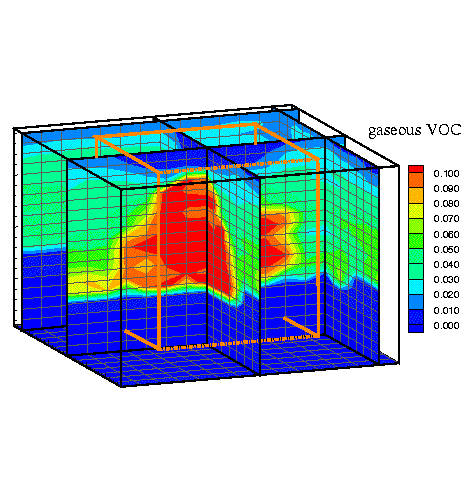 iTOUGH2 can also used to optimize operational parameters of a remediation system. For example, the injection and extraction rate of an air-sparging system can be automatically adjusted such that a minimum of contaminant remains in the system. The forward model used here is T2VOC, which calculates TCE migration in the NAPL, aqueous, and gas phase in the unsaturated zone of a highly heterogeneous aquifer. Air injection beneath the water table is simulated, and contaminated soil gas is extracted in the vadose zone. The objective function to be minimized contains energy and treatment costs as well as a penalty for incomplete remediation. Other terms such as installation and financial costs may be added. The optimized rates lead to a maximum contaminant removal in a given time.
iTOUGH2 can also used to optimize operational parameters of a remediation system. For example, the injection and extraction rate of an air-sparging system can be automatically adjusted such that a minimum of contaminant remains in the system. The forward model used here is T2VOC, which calculates TCE migration in the NAPL, aqueous, and gas phase in the unsaturated zone of a highly heterogeneous aquifer. Air injection beneath the water table is simulated, and contaminated soil gas is extracted in the vadose zone. The objective function to be minimized contains energy and treatment costs as well as a penalty for incomplete remediation. Other terms such as installation and financial costs may be added. The optimized rates lead to a maximum contaminant removal in a given time. ![]()